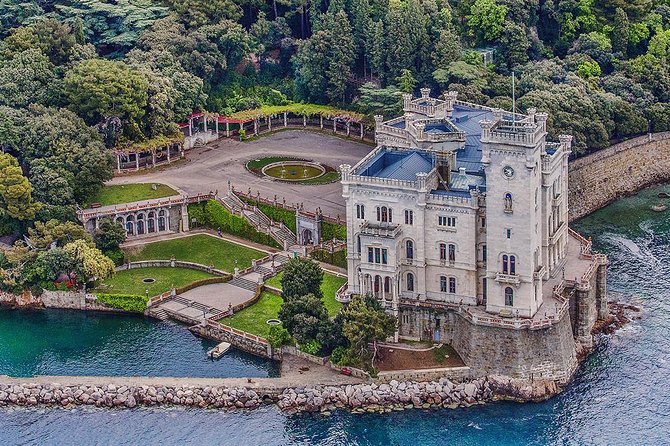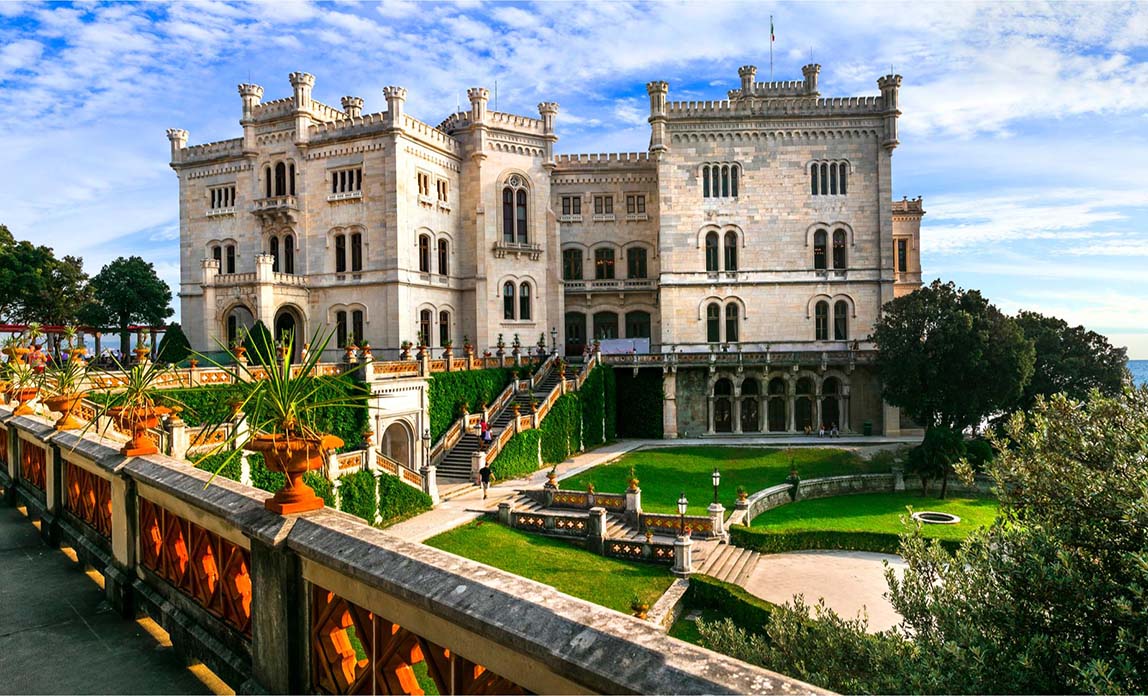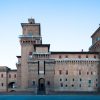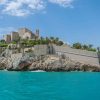Miramare Castle
Miramare Castle, perched on the edge of the Gulf of Trieste, is a stunning example of 19th-century architecture and aristocratic elegance. Constructed as the private residence of Archduke Ferdinand Maximilian of Habsburg and his wife, Princess Charlotte of Belgium, the castle reflects the grandeur of the Habsburg dynasty and stands as a symbol of their legacy in the region. The castle, with its eclectic architectural style and meticulously designed park, offers visitors a glimpse into the opulent lifestyle of European nobility.
Can’t wait to visit the castle? Book your Miramare Castle tour online.
Location of Miramare Castle
Miramare Castle sits on a rocky promontory in Grignano, about ten kilometers northwest of Trieste, Italy. Moreover, the castle’s position on the edge of the Adriatic Sea provides breathtaking views of the water and surrounding coastline. Archduke Maximilian carefully chose the site, drawn by the natural beauty and potential for a harmonious residence. Miramare Park, a 22-hectare garden, surrounds the castle, enhancing the landscape and offering a tranquil retreat. The park’s design blends Mediterranean and northern European influences, featuring a wide variety of imported botanical species. These species from around the world reflect the diverse interests and tastes of the period’s landscape design.

History of Miramare Castle
The history of Miramare Castle is deeply connected to the life and ambitions of Archduke Ferdinand Maximilian. Maximilian decided in 1856 to build a residence that reflected his rank and love for the sea. Austrian engineer Carl Junker designed the castle in an eclectic style, blending Gothic, Renaissance, and medieval architecture. These styles were popular among the European aristocracy of that era. The castle’s exterior was completed in 1860. Maximilian and his wife, Charlotte, moved into the castle on Christmas Eve of that same year. However, the interior was only partially finished at that time, with ongoing work continuing on the upper floors.
Maximilian’s aspirations extended beyond the castle; he also had grand visions for the surrounding landscape. He transformed the barren promontory into a lush garden, with help from several expert gardeners. He designed the park as a private garden, featuring winding paths, fountains, and a diverse collection of plants from around the world. Unfortunately, Maximilian’s time at Miramare was short-lived. In 1864, he accepted the offer to become Emperor of Mexico, a decision that would ultimately lead to his capture and execution in 1867. After his death, Charlotte briefly returned to Miramare before her deteriorating mental health forced her to leave.
Following the couple’s departure, the castle passed into the hands of the Habsburg family and later became property of the Italian state after World War I. During World War II, the castle was occupied by both German and Allied forces, which led to some damage and neglect.

Current status
Today, Miramare Castle operates as a museum, meticulously restored to offer visitors a unique historical experience. The museum displays original furnishings and personal items of Maximilian and Charlotte, preserving the space’s authentic 19th-century atmosphere. Visitors can explore richly decorated interiors, including the Throne Room, the Maximilian and Charlotte Apartments, and the Music Room. These rooms, filled with intricate details, reflect the grandeur of the Habsburg family’s lifestyle. Each area of the castle provides insight into the life of European nobility, making the visit both educational and memorable. Each of these spaces is adorned with intricate decorations that reflect the aristocratic tastes of the 19th century.
The surrounding Miramare Park remains a significant draw for visitors. Maximilian’s vision of a harmonious blend of art and nature is evident throughout the park, which features a wide array of plant species, sculptures, and water features. The park continues to undergo enhancements, with recent projects including the restoration of the historic greenhouses and the expansion of the park’s area to include additional land.
Miramare Castle serves as a museum and hosts various cultural events and exhibitions, keeping it vibrant and relevant. The castle and its park remain open year-round, attracting visitors worldwide to experience its beauty and history. This site symbolizes both European royalty’s grandeur and the enduring cultural heritage of the Friuli Venezia Giulia region. Whether interested in history, architecture, or Adriatic coast beauty, you will find Miramare Castle offers an enriching experience.
Admission
Community features
Castle features
Video
Location
Official website
Featured listings














